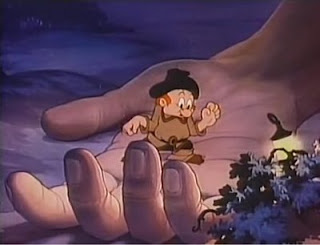Release Date: 12/22/1939
Distributed by: Paramount Pictures
Studio: Fleischer Studios
Running Time: 75 Minutes
Director: Dave Fleischer
Producer: Max Fleischer
Historical Significance:
- second cel-animated feature film ever released
- first produced by an American studio other than Walt Disney Productions
- first animated movie to feature rotoscoping
- first animated movie to feature rotoscoping
Background:
Max and Dave Fleischer had wanted to produce a feature as early as 1934, but Paramount, who distributed Fleischer's Popeye, Betty Boop, and Screen Songs cartoon shorts, vetoed the idea. However, after the success of Snow White and the Seven Dwarfs, Paramount agreed to allow the Fleischers to make a feature. Paramount offered to build the New York City-based Fleischers a new state-of-the-art animation studio in Miami Beach, Florida, away from the union influence which had polarized the Fleischer Studio after a bitter 1937 labor strike. The Fleischers agreed, and began development on Gulliver's Travels in spring 1938 as construction began on the Miami studio. The Miami Fleischer Studio opened in fall 1938, and the Fleischer staff moved their production headquarters there.
Plot Summary:
Gulliver washes ashore on Lilliput and attempts to prevent war between that tiny kingdom and its equally-miniscule rival, Blefiscu, as well as smooth the way for the romance between the Princess and Prince of the opposing lands. In this he is alternately aided and hampered by the Lilliputian town crier and general fussbudget, Gabby. A life-threatening situation develops when the bumbling trio of Blefiscu spies, Sneak, Snoop, and Snitch, manage to steal Gulliver's pistol.
Voice Cast:
Gulliver: Sam Parker
Gabby: Pinto Colvig
King Little, Sneak, Snoop, and Snitch: Jack Mercer
King Bombo: Tedd Pierce
Princess Glory: Jessica Dragonette
Prince David: Lanny Ross
Animation Style and Production:
Paramount wanted Gulliver ready for a Christmas 1939 release, meaning that the film would have to be produced on a timetable that was one-third of that for the production of Disney's Snow White. To meet this deadline, the Fleischer staff was greatly expanded, to the point that the once-spacious new building was overcrowded with employees. Local Miami art schools provided graduates to be trained as ink-and-paint artists and in-betweeners. Animators were lured from the Hollywood animation studios, including Cal Howard, Virgil Ross and Tedd Pierce from Leon Schlesinger Productions, and former Fleischer employees Grim Natwick, Al Eugster, Frank Smith and James Culhane, who had all migrated over to the Disney studio. Factions developed between the East and West Coast animators, who were unaccustomed to each others' habits. The two sides grew further apart after Howard, Pierce, and the other Hollywood storymen decided to discard the New York regime's storyboards, crafting the film's plot over again from scratch.
Rotoscoping, an animation technique originally developed by the Fleischer Studios, was used throughout Gulliver's Travels to animate Gulliver. The process involves tracing live-action footage frame-by-frame; Sam Parker, the actor who performed the voice of Gulliver, also modeled as the character's live-action reference. Popeye the Sailor had originally been planned to "portray" Gulliver, but these plans were scrapped during pre-production.
Differences from Book:
The story is based upon the Lilliputian adventures of Gulliver depicted in Jonathan Swift's 18th century novel Gulliver's Travels.
Music:
Songs in the film include "All's Well", "It's a Hap-Hap-Happy Day", and "Faithful Forever", all of which later became standards of Fleischer cartoon scores.
Funny Tidbits You Didn't Know:
- The film was spun off into two short-lived Fleischer cartoon short series: the Gabby cartoons starring the Pinto Colvig-voiced Lilliputian sidekick of the film, and the Sneak, Snoop and Snitch (Animated Antics) cartoons starring the three villains from the film.
- Like Snow White before it, Gulliver was a box-office success, and led to the production of another Fleischer/Paramount feature, Mister Bug Goes to Town. However, business-related problems which arose during the production of Mister Bug would result in Paramount's absorption of the Fleischer Studio in 1941, as the studio was in debt from unsuccessful cartoons and the simmering feud between Max and Dave reached new heights, as Dave had wanted to write the score for the film. Gulliver's Travels is now in the public domain, because its copyright was not renewed, and is widely available on home video and DVD.
Movie Links:
http://www.youtube.com/watch?v=E6eyrmYRk1w
http://www.youtube.com/watch?v=E6eyrmYRk1w







No comments:
Post a Comment